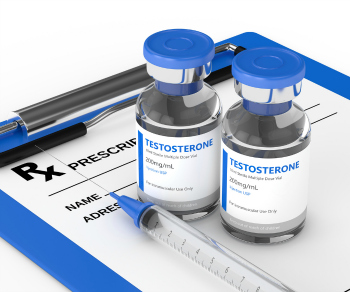Fewer Men Prescribed Testosterone After FDA Advisory

Ever since the U.S. Food and Drug Administration (FDA) expressed safety concerns about testosterone replacement therapy in 2015, the number of testosterone prescriptions has declined, according to recent research.
The drop has occurred even though the number of men seeking help for symptoms of low testosterone has remained steady over the same time period.
The findings were presented at the annual meeting of the American Urological Association, held in May 2018.
The medical term for low testosterone ishypogonadism,and doctors often prescribe testosterone replacement therapy to men whose bodies don’t make adequate amounts of this hormone on their own. Sometimes, this happens when the testes (the glands that produce testosterone) aren’t working properly. In other cases, there might be a problem with the part of the brain that triggers testosterone production.
Men’s testosterone levels also decline – gradually – as they get older. This is the natural course of aging, but some men start to feel tired, moody, and less interested in sex. Doctors might write prescriptions for these men, too.
In March 2015, the FDA announced changes in testosterone product labeling, specifying that the safety of testosterone in men with age-related hypogonadism was not completely clear, and that doctors should prescribe therapy only to men with certain medical conditions. The FDA was also concerned about an increased risk for heart attack and stroke in some patients, although this determination was controversial.
How much did prescriptions decline after the FDA advisory? Researchers looked at data from men between the ages of 45 and 84 who were prescribed transdermal (applied through a patch on the skin) or injectable forms of testosterone from March 2013 to August 2016. The men were patients at eight hospitals in the Boston area.
In March 2015, roughly 700 transdermal and 200 injectable testosterone prescriptions were written. The numbers fell substantially by July 2016, when fewer than 200 prescriptions for each type were written.
During that time, the number of men seeking help for low testosterone didn’t change significantly. The number of clinical encounters (times that men saw their doctor for a testosterone-related concern) averaged between 300 and 500 per month between March 2015 and December 2016.
In other words, even though the number of men seeing a doctor for symptoms of low testosterone stayed within the same range, fewer prescriptions were written.
In 2018, the American Urological Association issued new guidelines on the evaluation and management of testosterone deficiency, stating “at this time, it cannot be stated definitively whether testosterone therapy increases or decreases the risk of cardiovascular events (e.g., myocardial infarction, stroke, cardiovascular-related death, all-cause mortality).”
Some clinicians question whether doctors should be nervous about prescribing testosterone when cardiovascular risk is not clear.
Dr. Valary Raup, the study’s lead author told the Urology Times that if cardiovascular risk is not significant and doctors are reluctant to prescribe testosterone, “then you’re missing an opportunity to help a lot of people.”
Resources
American Urological Association (AUA)
“Evaluation and Management of Testosterone Deficiency”
(2018)
http://www.auanet.org/guidelines/testosterone-deficiency-(2018)
The Journal of Urology
Raup, Valary, et al.
“MP44-10 The Impact of the FDA Testosterone Supplementation Therapy Safety Advisory on Prescribing Patterns”
(Abstract presented at 2018 annual meeting of the American Urological Association, San Francisco, California, May 2018)
https://www.jurology.com/article/S0022-5347(18)40739-2/fulltext
SexHealthMatters.org
“FDA Announces Changes in Testosterone Labeling”
(March 11, 2015)
https://www.sexhealthmatters.org/news/fda-announces-changes-in-testosterone-labeling
Urology Times
Kuznar, Wayne
“T prescriptions see significant drop after FDA advisory”
(May 15, 2018)
http://urologytimes.com/aua-annual-meeting/t-prescriptions-see-significant-drop-after-fda-advisory
You may also be interested in...
Other Popular Articles

What Is Jelqing, and Does It Actually Work?
The term “jelqing” refers to a set of penis stretching exercises that some believe can make the penis bigger. Although the practice has gained attention and popularity in blogs and internet forums in recent years, there is no scientific evidence that it is an effective way to permanently increase the size of one’s penis. In fact, in some cases, jelqing may actually cause damage to the penis, so it is a good idea to get all the facts before setting off to try it.

What Is the Average Penis Size?
If you have ever wondered how your penis compares to others in terms of size, you are not alone. Many men are curious to know how their penises stack up compared to the average. Unfortunately, general curiosity can sometimes give way to full-on obsession and anxiety about penis size. This can be an unhealthy and often unnecessary fixation, especially because most men who think their penises are too small have perfectly normal-sized penises.

What Is Sensate Focus and How Does It Work?
Sensate focus is a technique used to improve intimacy and communication between partners around sex, reduce sexual performance anxiety, and shift away from ingrained, goal-oriented sexual patterns that may not be serving a couple.

Can Sex Reduce Menstrual Cramps?
The SMSNA periodically receives and publishes ‘guest editorials.’ The current article was submitted by Mia Barnes, a freelance writer and researcher who specializes in women's health, wellness, and healthy living. She is the Founder and Editor-in-Chief of Body+Mind Magazine.
Having sex while you experience menstrual cramps is healthy and can provide significant benefits. While it might not be the first activity that comes to mind when your PMS or period cramping begins, many people enjoy sex to reduce menstrual cramps, experience increased pleasure and benefit from other advantages. Learn more about having sex while menstrual cramps are happening and how it can help your body.

How Long Does It Take the Average Man to Ejaculate?
On average, it takes a man between 5 to 7 minutes to orgasm and ejaculate during sexual intercourse.

The Effect of Regular Aerobic Exercise on Erectile Function
Erectile dysfunction (ED) is the inability to achieve or maintain an erection sufficient for satisfactory sexual activity. As men get older, their erectile functioning may naturally decline due to changes in testosterone levels, cardiovascular functioning, and the potential development of other chronic medical conditions that become more common with age.
You are prohibited from using or uploading content you accessed through this website into external applications, bots, software, or websites, including those using artificial intelligence technologies and infrastructure, including deep learning, machine learning and large language models and generative AI.

